Setting up HLS Channels: Difference between revisions
No edit summary |
Updated to 11V |
||
| Line 1: | Line 1: | ||
''This is based on version 11V.'' | |||
====Introduction==== | |||
---- | |||
[[File:Manage-Channels-Menu.png|thumb|Figure 3-1]] | [[File:Manage-Channels-Menu.png|thumb|Figure 3-1]] | ||
<br /> | <br /> | ||
| Line 11: | Line 13: | ||
[[File:TimeReminder.jpg|thumb|Figure 3-2]] | [[File:TimeReminder.jpg|thumb|Figure 3-2]] | ||
Next we will set up output channels. Click on the '''Manage Channels''' tab at the top of the page and then click on '''Manage Raw Channels'''. At this point you will see a message reminding you to choose your time period resolution before you continue (see Figure 3-2). Next, click on the OK button. | Next we will set up output channels. Click on the '''Manage Channels''' tab at the top of the page and then click on '''Manage Raw Channels'''. At this point you will see a message reminding you to choose your time period resolution before you continue (see Figure 3-2). Next, click on the OK button. | ||
<br clear=all> | |||
====Adding Basic Channels==== | |||
---- | |||
The '''Channel Manager''' screen will now as appear (see Figure 3-3). This is where we will add and configure new channels. At this point, you will not actually be assigning channels to a controller. To add channels: | |||
# In the ''# of Channels to Add'' field, type the numeric value of number of channels to add. | |||
# Click the ''Add'' button to create the channels. | |||
[[File:Channel Manager.jpg|thumb|900px|Figure 3-3]] | |||
<br clear=all> | |||
====Naming Channels==== | |||
---- | |||
[[File:Channel-Manager-Name.jpg|thumb|Figure 3-4]] | |||
HLS will pop up a window asking for the common name for the channels (See Figure 3-4). You can enter anything in the blank and HLS will auto-number the channels, starting at 1. If you would rather NOT start at 1, you can input a different number in parenthesis. For example, to add channels starting with number 15, you could enter ''Chan(15)'' into the box. Hit Enter when complete. | |||
<br clear=all> | |||
====Changing the Assigned Universe==== | |||
---- | |||
[[File:Channel-Manager-Universe.png|thumb|Figure 3-5]] | |||
When adding channels, HLS automatically assigns them to '''Universe 0'''. Any channels assigned to Universe 0 will NOT output to controllers or a preview window. So, the first thing to do after adding the channels is to assign them to a "real" universe. | |||
*In the example of Figure 3-5, 24 channels have been added. | |||
*To change them to '''Universe 1''': | |||
**Select all channels to change by clicking on the top channel (inside any box) and drag the mouse cursor down until all channels are selected. | |||
**Enter the number one is into the '''Renumber Selected Universe''' field | |||
**Click the '''Renumber Universe''' button. | |||
<br clear=all> | |||
====Assigning Channel Numbers==== | |||
---- | |||
[[File:Channel-Manager-NumberChannel.png|thumb|Figure 3-6]] | |||
HLS does not automatically assign channel numbers. To assign channel numbers: | |||
*Select all channels to number/renumber by clicking and dragging from the top channel to the last. | |||
*Click the '''ReNumber All Channels for Output''' button. | |||
*Figure 3-6 demonstrates what this would look like after pressing the button with 24 new channels. | |||
<br clear=all> | |||
====Applying Colors to Channels==== | |||
[[File:Channel Manager | ---- | ||
[[File:Channel-Manager-Color-Picker.png|thumb|Figure 3-7]] | |||
Setting a color for a channel is important as it is the color that appears in the sequencer as you add effects and is also used in the Display Preview. HLS has a simple and straight-forward way to do so. | |||
*In the top right corner, there is a color block. Click it to bring up the '''Color Picker''' (See figure 3-7). | |||
*Once the Color Picker is open, you can easily set it to one of the more common lighting colors or you can click the drop down box in the bottom left to choose any color you like. | |||
*Once you have selected a color, click OK to use it. | |||
*Right-click in the '''Color''' column of any channels you want to be demonstrated with that color. (See figure 3-8.) | |||
*'''Hint:''' To save time, choose one color at a time and set all same-colored channels at the same time before switching to another color. | |||
[[File:Channel-Manager-Colored-Channels.png|thumb|Figure 3-8]] | |||
<br clear=all> | |||
Figure | |||
[[File: | |||
====Simple Renaming==== | |||
---- | |||
[[File:Channel-Manager-Simple-Renaming.png|thumb|px700|Figure 3-9]] | |||
Generally, you won't want to keep a bunch of channels with the same name. Simple renaming of individual channels is simple. In the example shown in Figure 3-9, the first channel has been renamed and the second channel is in process of being renamed. | |||
*First, you MUST check the '''UnFreeze Name to Edit''' box in the top left. | |||
*Once names are unlocked, click into the field and type a new name. | |||
*More complex group renaming is in the [[Changing the Channel Configuration]] section. | |||
<br clear=all> | |||
{| class="wikitable" | {| class="wikitable" | ||
| Line 62: | Line 80: | ||
| align="center" | [[HLS User Manual and Reference Guide#Creating_a_Sequence | Chapter 2: Creating a Sequence]] | | align="center" | [[HLS User Manual and Reference Guide#Creating_a_Sequence | Chapter 2: Creating a Sequence]] | ||
| align="center" | [[HLS User Manual and Reference Guide#Channel_Management | Chapter 3: Channel Management]] | | align="center" | [[HLS User Manual and Reference Guide#Channel_Management | Chapter 3: Channel Management]] | ||
| align="center" | [[ | | align="center" | [[Changing the Channel Configuration]] | ||
|} | |} | ||
<br /><br /> | <br /><br /> | ||
Revision as of 06:28, 26 January 2013
This is based on version 11V.
Introduction
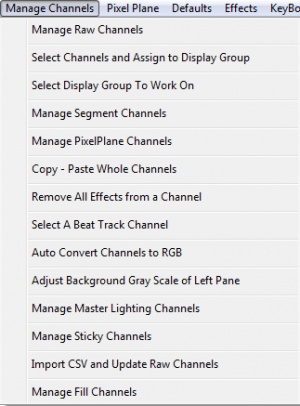
Channels are controlled using the Manage Channels Menu at the top of the screen. See figure 3-1. While there are many functions on this menu, this document will mainly focus on the first option: Manage Raw Channels. Select this option to add and manipulate the raw channels associated with the sequence you are working with.
Important: If you plan to use a time resolution that is different than the default (50 msec), it MUST be set BEFORE you add any channels. Once you add channels, this time resolution CANNOT be changed.
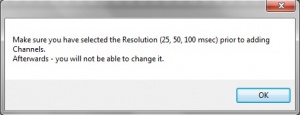
Next we will set up output channels. Click on the Manage Channels tab at the top of the page and then click on Manage Raw Channels. At this point you will see a message reminding you to choose your time period resolution before you continue (see Figure 3-2). Next, click on the OK button.
Adding Basic Channels
The Channel Manager screen will now as appear (see Figure 3-3). This is where we will add and configure new channels. At this point, you will not actually be assigning channels to a controller. To add channels:
- In the # of Channels to Add field, type the numeric value of number of channels to add.
- Click the Add button to create the channels.
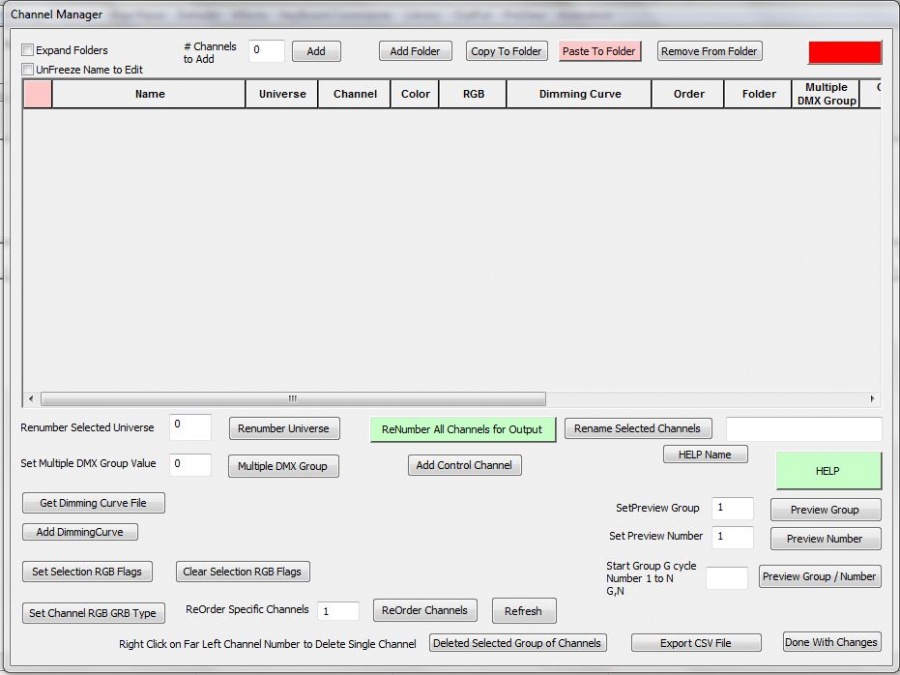
Naming Channels
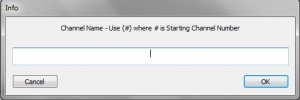
HLS will pop up a window asking for the common name for the channels (See Figure 3-4). You can enter anything in the blank and HLS will auto-number the channels, starting at 1. If you would rather NOT start at 1, you can input a different number in parenthesis. For example, to add channels starting with number 15, you could enter Chan(15) into the box. Hit Enter when complete.
Changing the Assigned Universe
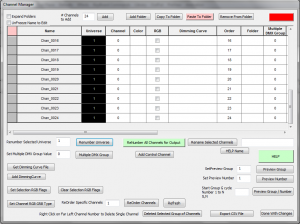
When adding channels, HLS automatically assigns them to Universe 0. Any channels assigned to Universe 0 will NOT output to controllers or a preview window. So, the first thing to do after adding the channels is to assign them to a "real" universe.
- In the example of Figure 3-5, 24 channels have been added.
- To change them to Universe 1:
- Select all channels to change by clicking on the top channel (inside any box) and drag the mouse cursor down until all channels are selected.
- Enter the number one is into the Renumber Selected Universe field
- Click the Renumber Universe button.
Assigning Channel Numbers
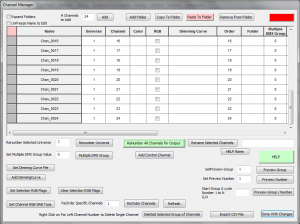
HLS does not automatically assign channel numbers. To assign channel numbers:
- Select all channels to number/renumber by clicking and dragging from the top channel to the last.
- Click the ReNumber All Channels for Output button.
- Figure 3-6 demonstrates what this would look like after pressing the button with 24 new channels.
Applying Colors to Channels
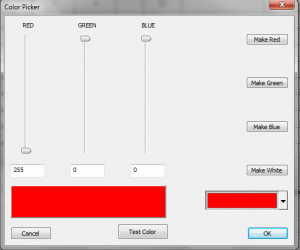
Setting a color for a channel is important as it is the color that appears in the sequencer as you add effects and is also used in the Display Preview. HLS has a simple and straight-forward way to do so.
- In the top right corner, there is a color block. Click it to bring up the Color Picker (See figure 3-7).
- Once the Color Picker is open, you can easily set it to one of the more common lighting colors or you can click the drop down box in the bottom left to choose any color you like.
- Once you have selected a color, click OK to use it.
- Right-click in the Color column of any channels you want to be demonstrated with that color. (See figure 3-8.)
- Hint: To save time, choose one color at a time and set all same-colored channels at the same time before switching to another color.
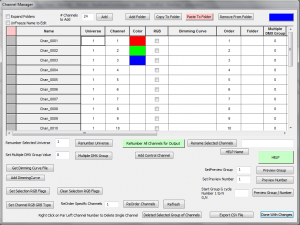
Simple Renaming
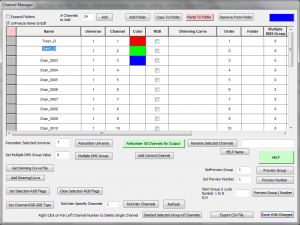
Generally, you won't want to keep a bunch of channels with the same name. Simple renaming of individual channels is simple. In the example shown in Figure 3-9, the first channel has been renamed and the second channel is in process of being renamed.
- First, you MUST check the UnFreeze Name to Edit box in the top left.
- Once names are unlocked, click into the field and type a new name.
- More complex group renaming is in the Changing the Channel Configuration section.
| HLS User Manual and Reference Guide | ||
|---|---|---|
| Previous Page | Current Chapter | Next Page |
| Chapter 2: Creating a Sequence | Chapter 3: Channel Management | Changing the Channel Configuration |